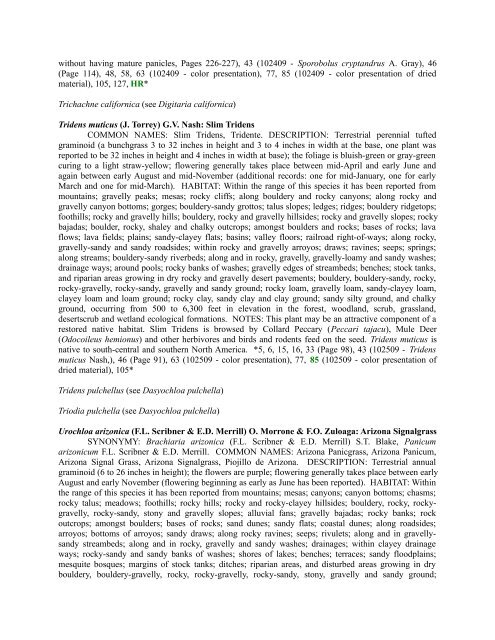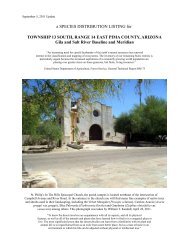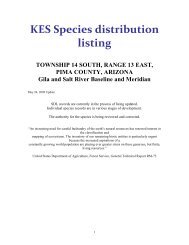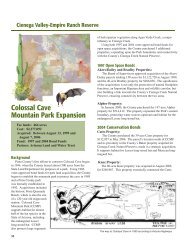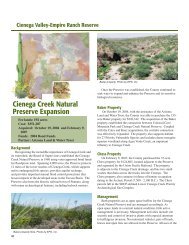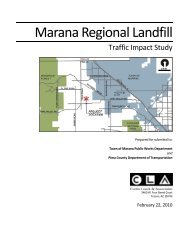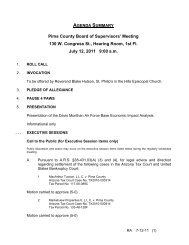Le Jardin de Mère Nature dans une Petite Planète - Pima County
Le Jardin de Mère Nature dans une Petite Planète - Pima County
Le Jardin de Mère Nature dans une Petite Planète - Pima County
Create successful ePaper yourself
Turn your PDF publications into a flip-book with our unique Google optimized e-Paper software.
without having mature panicles, Pages 226-227), 43 (102409 - Sporobolus cryptandrus A. Gray), 46<br />
(Page 114), 48, 58, 63 (102409 - color presentation), 77, 85 (102409 - color presentation of dried<br />
material), 105, 127, HR*<br />
Trichachne californica (see Digitaria californica)<br />
Tri<strong>de</strong>ns muticus (J. Torrey) G.V. Nash: Slim Tri<strong>de</strong>ns<br />
COMMON NAMES: Slim Tri<strong>de</strong>ns, Tri<strong>de</strong>nte. DESCRIPTION: Terrestrial perennial tufted<br />
graminoid (a bunchgrass 3 to 32 inches in height and 3 to 4 inches in width at the base, one plant was<br />
reported to be 32 inches in height and 4 inches in width at base); the foliage is bluish-green or gray-green<br />
curing to a light straw-yellow; flowering generally takes place between mid-April and early J<strong>une</strong> and<br />
again between early August and mid-November (additional records: one for mid-January, one for early<br />
March and one for mid-March). HABITAT: Within the range of this species it has been reported from<br />
mountains; gravelly peaks; mesas; rocky cliffs; along boul<strong>de</strong>ry and rocky canyons; along rocky and<br />
gravelly canyon bottoms; gorges; boul<strong>de</strong>ry-sandy grottos; talus slopes; ledges; ridges; boul<strong>de</strong>ry ridgetops;<br />
foothills; rocky and gravelly hills; boul<strong>de</strong>ry, rocky and gravelly hillsi<strong>de</strong>s; rocky and gravelly slopes; rocky<br />
bajadas; boul<strong>de</strong>r, rocky, shaley and chalky outcrops; amongst boul<strong>de</strong>rs and rocks; bases of rocks; lava<br />
flows; lava fields; plains; sandy-clayey flats; basins; valley floors; railroad right-of-ways; along rocky,<br />
gravelly-sandy and sandy roadsi<strong>de</strong>s; within rocky and gravelly arroyos; draws; ravines; seeps; springs;<br />
along streams; boul<strong>de</strong>ry-sandy riverbeds; along and in rocky, gravelly, gravelly-loamy and sandy washes;<br />
drainage ways; around pools; rocky banks of washes; gravelly edges of streambeds; benches; stock tanks,<br />
and riparian areas growing in dry rocky and gravelly <strong>de</strong>sert pavements; boul<strong>de</strong>ry, boul<strong>de</strong>ry-sandy, rocky,<br />
rocky-gravelly, rocky-sandy, gravelly and sandy ground; rocky loam, gravelly loam, sandy-clayey loam,<br />
clayey loam and loam ground; rocky clay, sandy clay and clay ground; sandy silty ground, and chalky<br />
ground, occurring from 500 to 6,300 feet in elevation in the forest, woodland, scrub, grassland,<br />
<strong>de</strong>sertscrub and wetland ecological formations. NOTES: This plant may be an attractive component of a<br />
restored native habitat. Slim Tri<strong>de</strong>ns is browsed by Collard Peccary (Peccari tajacu), Mule Deer<br />
(Odocoileus hemionus) and other herbivores and birds and ro<strong>de</strong>nts feed on the seed. Tri<strong>de</strong>ns muticus is<br />
native to south-central and southern North America. *5, 6, 15, 16, 33 (Page 98), 43 (102509 - Tri<strong>de</strong>ns<br />
muticus Nash,), 46 (Page 91), 63 (102509 - color presentation), 77, 85 (102509 - color presentation of<br />
dried material), 105*<br />
Tri<strong>de</strong>ns pulchellus (see Dasyochloa pulchella)<br />
Triodia pulchella (see Dasyochloa pulchella)<br />
Urochloa arizonica (F.L. Scribner & E.D. Merrill) O. Morrone & F.O. Zuloaga: Arizona Signalgrass<br />
SYNONYMY: Brachiaria arizonica (F.L. Scribner & E.D. Merrill) S.T. Blake, Panicum<br />
arizonicum F.L. Scribner & E.D. Merrill. COMMON NAMES: Arizona Panicgrass, Arizona Panicum,<br />
Arizona Signal Grass, Arizona Signalgrass, Piojillo <strong>de</strong> Arizona. DESCRIPTION: Terrestrial annual<br />
graminoid (6 to 26 inches in height); the flowers are purple; flowering generally takes place between early<br />
August and early November (flowering beginning as early as J<strong>une</strong> has been reported). HABITAT: Within<br />
the range of this species it has been reported from mountains; mesas; canyons; canyon bottoms; chasms;<br />
rocky talus; meadows; foothills; rocky hills; rocky and rocky-clayey hillsi<strong>de</strong>s; boul<strong>de</strong>ry, rocky, rockygravelly,<br />
rocky-sandy, stony and gravelly slopes; alluvial fans; gravelly bajadas; rocky banks; rock<br />
outcrops; amongst boul<strong>de</strong>rs; bases of rocks; sand d<strong>une</strong>s; sandy flats; coastal d<strong>une</strong>s; along roadsi<strong>de</strong>s;<br />
arroyos; bottoms of arroyos; sandy draws; along rocky ravines; seeps; rivulets; along and in gravellysandy<br />
streambeds; along and in rocky, gravelly and sandy washes; drainages; within clayey drainage<br />
ways; rocky-sandy and sandy banks of washes; shores of lakes; benches; terraces; sandy floodplains;<br />
mesquite bosques; margins of stock tanks; ditches; riparian areas, and disturbed areas growing in dry<br />
boul<strong>de</strong>ry, boul<strong>de</strong>ry-gravelly, rocky, rocky-gravelly, rocky-sandy, stony, gravelly and sandy ground;


